To make red color from the paints of the usual palette, use secondary colors that contain this dye. Red color is one of the 3 basic colors that cannot be composed of other colors, but you can use their derivatives and get shades of red or another color using the same principle.
Theory of obtaining red color from other colors. Proportions
Getting red by mixing other colors can be a useful skill when you run out of the right dye or don't have the right shade on your palette. This skill can be useful for artistic, design, decorative, or other purposes.
To make red, you can use derivative colors based on red. These are colors that were obtained by mixing with red paint.
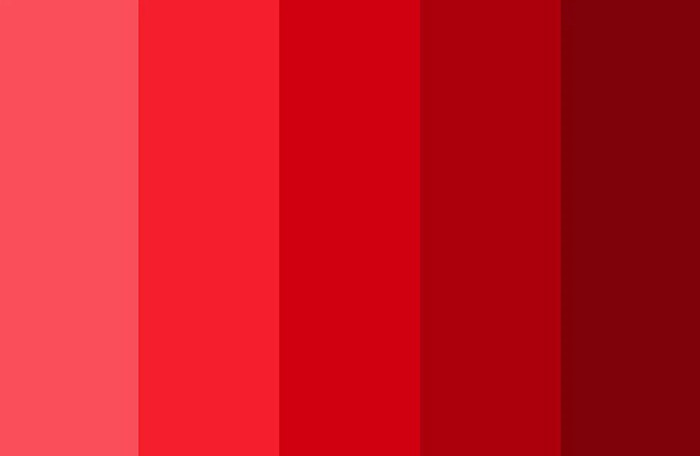
Examples of such colors:
- magenta (obtained by mixing 1:1 yellow and red);
- medium red (obtained by mixing 2:1 carmine and yellow);
- orange-red (obtained by mixing 2:1 pink and yellow paint).
If there is red color in the palette, but you need to get a new shade based on this paint, you also resort to mixing dyes.
| Shade | Components |
| Rich red | 2 parts red and 1 part yellow |
| Red-orange | 1 part red and 1 part yellow, 1 part orange and 1 part red |
| Soft red | 1 part red and 1 part pink |
| Light red | red with white |
| Wine | red and any dark shade (purple, blue, black) |
| Royal red | 1 part red and 1 part blue |
| Dark red | 1 part green and 3 parts red |
| Dark brown | 1 part red and 1 part brown |
How to get red color from water paints
You can make red color from water-based paints by following special mixing schemes.
Artists or designers working with such paints divide the base into 2 types:
- to obtain dark tones;
- to obtain light tones.
In the first case, the color that needs to be darkened is taken as a base. Black paint is mixed into it in small doses. The dye is added carefully so that the new tone does not turn out with a dirty admixture.
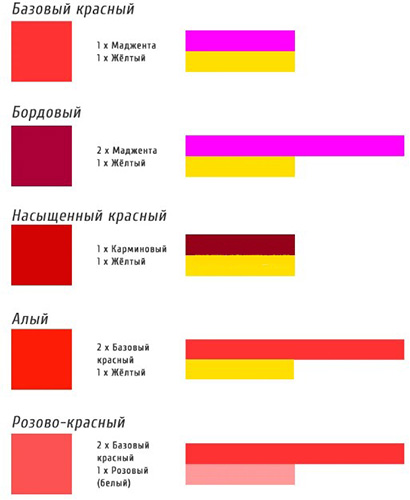
For lightening, I use white dye or whitewash as a base. Gradually, the color that needs to be lightened is mixed into the base. The less of the original color in the finished mixture, the lighter its tone. Water-soluble paints are also easily lightened by adding water.
Red shades can be obtained from water-based paints by mixing red and yellow dyes. The saturation of the new shade will depend on the saturation of the original dyes or on the addition of additional colors. For example, white will lighten the tones to coral, peach or pink.
How to Make Red from Oil Paints
To obtain a new shade, paints are mixed on a palette or directly on the canvas. Some mixing methods help to obtain unusual color effects.
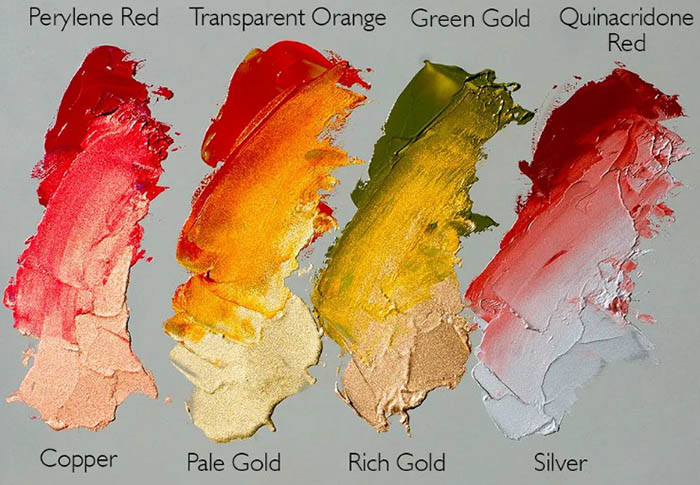
There are 3 main methods for mixing oil paints.
- Physical mixing. To do this, 2 or more colors are mixed mechanically on a palette or other surface to obtain a new shade.
- Overlay of colors. The initial color is applied to the canvas and the brushstrokes are left to dry. The next color is applied on top in a thin, almost transparent layer. As a result, the colors mix, showing through from under each other.
- Color adjacency. The most difficult method of mixing. To do this, make small strokes of different colors close to each other and at the right angle. As a result, the colors mix due to an optical illusion.
How to make red color from gouache paints
You can make red using different techniques, but they are all similar to each other due to the creamy texture of the pigments. If the paints have dried out a little, they are first diluted to the desired consistency by adding water. The shade of gouache is corrected by adding white, which can make the tone less saturated or lighter.
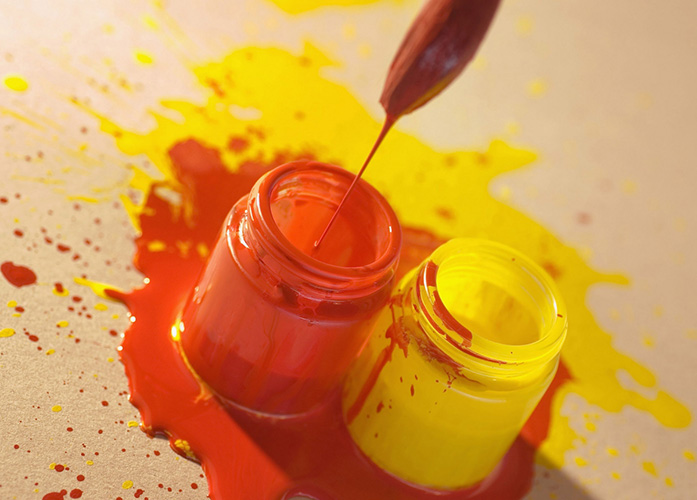
The advantage of mixing gouache is that each new layer of paint can completely cover the previous one. Therefore, you can cover a failed stroke or a layer of red. At the same time, the paint is not diluted with water so that its structure remains thick.
If you have run out of red in your paint set, you can try to achieve it by mixing the following colors:
- bright pink with yellow;
- black and yellow;
- burgundy and yellow;
- blue with orange.
Mixing proportions may vary to achieve different color saturations, so try making several paint mixtures first and test them on paper or canvas.
How to Make Red Color with Acrylic Paints
Acrylic paints are easy to use and mix. These paints dry quickly, but have a limited color palette. Therefore, shades of red are often created manually. To create red, if it is not in the palette set, use a general color mixing scheme.
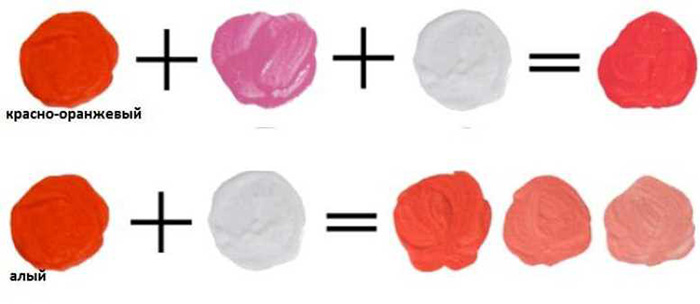
When mixing acrylic paints, follow the recommendations.
- The surface to be painted is cleaned of any type of dirt - stripped, leveled, degreased.
- Acrylic is pre-diluted with a solution or water. They are mixed in a separate container.
- Mix the necessary paints and apply them to the surface in several stages, each time waiting for the previous layer to dry. The paint is applied in one direction.
- If acrylic is used to cover walls or other large surfaces, ensure that the air temperature in the room is between +7 and +17.
How to make red color from watercolor paints
Red can be made from water-based paints, like watercolors, by mixing 2 or more dyes. Watercolors are mixed in 2 ways - by layering or mechanical mixing. In the first case, color mixing is achieved through a visual effect.
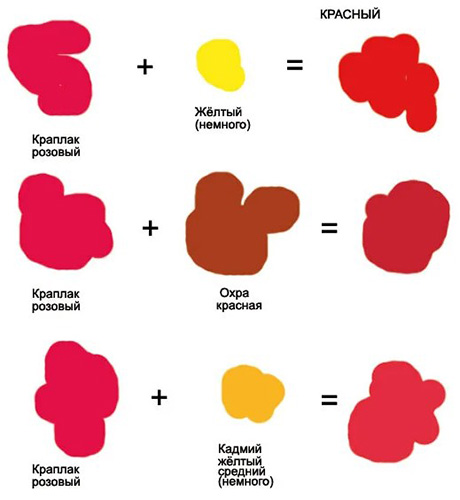
To do this, follow the algorithm.
- The paper is covered with a light tone. To obtain this tone, paint is mixed with water.
- Wait for the layer to dry and apply a light tone of other dyes on top. Each time, wait for the previous layer to dry.
- Repeat this algorithm several times until you get the desired tone. It is recommended to mix different colors no more than 5 times to avoid a dirty shade.
In the second case, the mixing of colors occurs on the palette in the following order.
- Using a wet brush, pick up some paint and apply it to the palette. Add a little water if necessary.
- Add a small amount of additional pigment until the desired tone is achieved.
- Make a test smear on paper and, if necessary, add more dye to the mixture or begin coloring.
When mixing paints, follow the universal color mixing schemes. Depending on the saturation of the watercolor tone, the saturation of the finished mixture may change.
How to make red color from plasticine
Plasticine is mixed when one of the colors in the set runs out or the desired color is missing. Different colors of plasticine are mixed according to the same principle as dyes, but the density of the mass composition is taken into account, which requires careful and long mechanical mixing.
To obtain a red color or shade of plasticine, follow the algorithm.
- Separate the balls of red and auxiliary color or 2 colors to obtain the desired shade of red and combine them, kneading thoroughly.
- Adjust the finished tone of the plasticine by adding the desired color little by little.
- Mixing plasticine will not produce a true red color, but you can achieve a bright or dark, rich or pale shade.
How to make red color from pencils
Red can be made from solid paints (watercolor, wax, chalk, pastel pencils) only from the colors that are part of red.
It is not possible to achieve a pure color by mixing dyes, but you can get shades of red by mixing its derivatives:
- black and yellow;
- orange and blue;
- pink and yellow;
- purple and yellow.
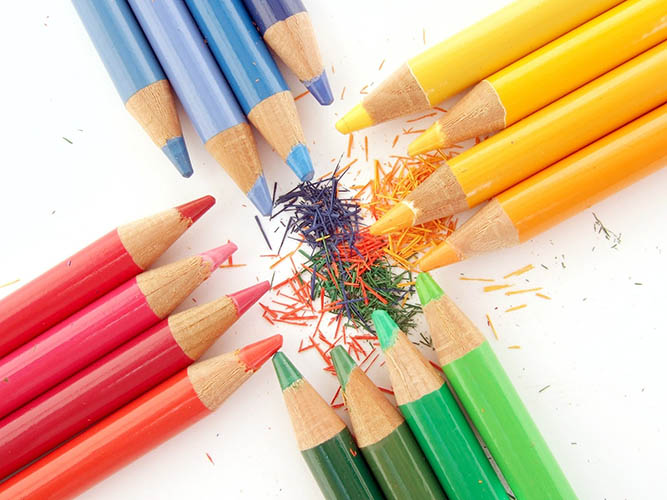
The colors of the pencils are mixed by superimposing the colors one on top of another. To do this, make strokes or dots of 2 colors close to each other and in the same direction to create an optical effect. You can try superimposing the shading of one color on top of another, but pencils of different compositions can give different results and sometimes a dirty shade is obtained.
| Type of pencils | Mixing feature |
| Chalk | Mix by shading in one direction, shading and rubbing. Even out the color by rubbing with a finger or paper. |
| Pastel | |
| Wax | Mix by overlapping, close hatching in one direction, cross hatching. Even out the color with an eraser, chalk white pencil. |
| Solid | Mix by superposition, close hatching in one direction, cross hatching. |
How to make red color from markers
It is impossible to obtain red from markers by mixing, since it is the main color that is included in most colors and shades. But by mixing, you can achieve a similar color or shade in a brighter, darker or more saturated form.

They use standard color mixing schemes, but take into account the peculiarities of working with markers.
- Do not mix more than 3 colors at a time to avoid dirty shades.
- They use similar colors located on the color wheel, but in different shades.
- To dilute and lighten the color, use a zero marker.
- The mixing process is quick while the marker dye is still wet.
- After drying, the marker color becomes lighter.
- A more languid tone is achieved by applying the same marker several times.
- Mix markers, starting from light tones and moving on to dark ones.
- Mix colors in circular motions rather than zigzag ones.
Adviсe
To make red from paints, they resort to different proportions and schemes of mixing dyes, the result of which may depend on the shade of the components and the type of paint.
If you follow the mixing tips, the process of obtaining the desired shade can be faster and easier.
- You can mix any dyes, including those like plasticine. The thicker the paint or material, the longer the mixing process will take to avoid inclusions or streaks.
- When mixing colors using a color wheel, check their combination by proximity or distance. Mixing closely spaced colors produces rich shades, while far-away colors produce muted tones with a gray undertone.
- Red can be mixed with most secondary hues to create new tones without polluting the hue. They are added in small quantities so that the red tone does not disappear completely. For example, yellow can lead to orange, and blue to violet.
- Change the saturation of the color by adding black or white. White will lighten the red, but too much white will make it pink. Adding black will make it dark red, but if you add too much black, the red will be hard to recognize.
- Several secondary colors are prepared in advance for ease of mixing and obtaining new tones of red.
- Before starting to mix new shades of red, make a smear of pure red on paper to compare the original color with the resulting one.
- A warmer or cooler shade of red is obtained by adding orange or violet. The proportion of 1:2 allows you to preserve the saturation of red. If you mix paints in a proportion of 1:1, the red tone becomes less noticeable in the finished mixture.
- You can get a brown shade of red by mixing paint with green.
Video about getting color
How to get a paint color that you don't have on hand:
